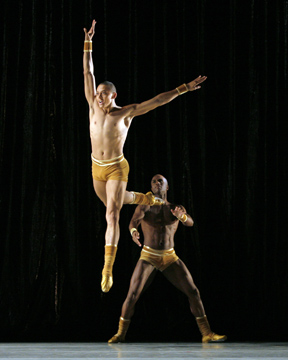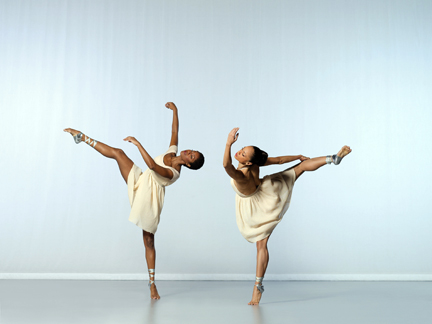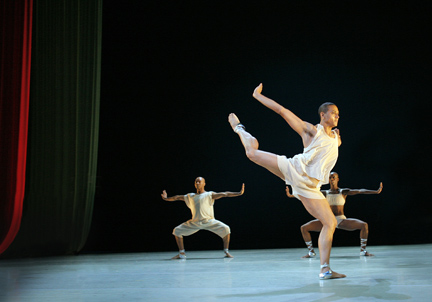“Pas De Duke”, “The Golden Section”, “Revelations” / “Episodes”, “Gamelan Gardens”, “Revelations”
Alvin Ailey American Dance Theater
City Center
New York, NY
November 29 & December 1, 2006
by Susan Reiter
copyright 2006 by Susan Reiter
 They don’t hold back on the speeches at an Alvin Ailey gala, but most of the verbiage that poured forth from the stage — particularly from the ever-vibrant Judith Jamison, who has led the company so ably for 17 years — was heartfelt, if somewhat obligatory. The two honorary chairpersons — i.e. celebrities — who spoke were well-chosen. The exceptional actress S. Epatha Merkerson clearly knows and understands what the Ailey company is about; she re called being taken to see them perform back in 1968 as a surprise 16thbirthday gift. And Rosie Perez, who came onstage prior to the concluding “Revelations” to add her buoyant presence, added some welcome down-to-earth sass to the proceedings. Soon after she began reading the fulsome — and, let’s face it, unnecessary — paean to the enduring greatness of the piece we were about to see, she stopped and eyed the audience. “Can you tell I didn’t write this myself?” she asked, to appreciative laughter.
They don’t hold back on the speeches at an Alvin Ailey gala, but most of the verbiage that poured forth from the stage — particularly from the ever-vibrant Judith Jamison, who has led the company so ably for 17 years — was heartfelt, if somewhat obligatory. The two honorary chairpersons — i.e. celebrities — who spoke were well-chosen. The exceptional actress S. Epatha Merkerson clearly knows and understands what the Ailey company is about; she re called being taken to see them perform back in 1968 as a surprise 16thbirthday gift. And Rosie Perez, who came onstage prior to the concluding “Revelations” to add her buoyant presence, added some welcome down-to-earth sass to the proceedings. Soon after she began reading the fulsome — and, let’s face it, unnecessary — paean to the enduring greatness of the piece we were about to see, she stopped and eyed the audience. “Can you tell I didn’t write this myself?” she asked, to appreciative laughter.
Fortunately, the talking did give way to some fantastic dancing, for what amounted to a truly festive program. The return of Ailey’s 1976 “Pas de Duke” to the repertory was given a gala spin, with each of its three casts taking on one portion of the piece. So while this was not the ideal way to re-evaluate how the work looks today, it did showcase some of the company’s finest, and contrasting dancers. Dwana Adiaha Smallwood and Antonio Douthit were the sleek, exuberant performers of the opening, mostly side-by-side duet. Douthit (whom some may recall from his brief but impressive stint with Dance Theater of Harlem, just before the company suspended operations), negotiated a speedy sequence of pirouettes with deft insouciance. The central solos were performed by Mathew Rushing, who blazed through the choreography powerfully, and Linda Celesta Sims, who brought glamorous allure to hers, which was set to the most jagged and contemporary of the five Duke Ellington compositions. Asha Thomas and Clifton Brown were playful and invigorating as they traded off in the coda, joined by the other two pairs for the final moments. All six dancers exemplify the sensational technical facility and vivid personalities of today’s Ailey roster. But there is no way to re-create the original incongruous but fascinating stylistic — and physical match-up between Judith Jamison and Mikhail Baryshnikov that was the work’s raison d’être. But it’s an invigorating party piece, and a reminder of how Ellington’s music was such a great inspiration for Ailey.
 The evening’s centerpiece — and the season’s most noteworthy addition to the repertoire — was the company premiere of Twyla Tharp’s “The Golden Section,” created for her company in 1981as the conclusion of “The Catherine Wheel.” It may be a quarter-century old, and include a few allusions to the club dancing of its time, but its glorious bursts of thrilling, celebratory no-holds-barred dancing resonate timelessly. The sometimes funky, sometimes athletic, always inspired choreography celebrates individual virtuosity but its overall emphasis is on cooperation, as the dancers dive into daring lifts and catches with gleeful abandon.
The evening’s centerpiece — and the season’s most noteworthy addition to the repertoire — was the company premiere of Twyla Tharp’s “The Golden Section,” created for her company in 1981as the conclusion of “The Catherine Wheel.” It may be a quarter-century old, and include a few allusions to the club dancing of its time, but its glorious bursts of thrilling, celebratory no-holds-barred dancing resonate timelessly. The sometimes funky, sometimes athletic, always inspired choreography celebrates individual virtuosity but its overall emphasis is on cooperation, as the dancers dive into daring lifts and catches with gleeful abandon.
They launch themselves onto the stage, mostly in trios and quartets, as though we are seeing just a glimpse of some Olympian event that extends into the wings. Brilliant, surprising solos hold the stage for brief moments here and there (Matthew Rushing and Jamar Roberts made particularly powerful impressions) but mostly they cooperate and assist one another, either in rough-and-tumble unison action, or in ever more swift and airborne partnering. This Ailey cast already radiated high spirits and mutual appreciation, as though spurring each other on as David Byrne’s edgy, pulsating music carried them along through increasingly speedy and daring activity. They were so fleet and sleek that one felt they lacked a certain grounded, even eccentric quality. The Tharp originals of 1981 were not only the greatest group of dancers she ever assembled, but an ensemble of defiantly quirky individuals. If it’s not possible to re-create that, the ultra-capable Ailey dancers will probably with time find a way to inject a bit more individual flavor. But they have already seized on this fantastic challenge with incredible aplomb. Just when the action has become as dense and intricate as seems possible with thirteen bodies onstage, the stage clears, leaving Linda Celeste Sims unspooling luxurious turns and gamboling as though through a private mediation, until her casual leap off into the wings as the music reaches its final note. That’s all we get to see, but we can imagine this physical embodiment of nirvana is continuing there in the wings ad infinitum.
Kudos to Shelley Washington, who staged this production, for transmitting the daring spirit of the original and for casting these demanding roles so astutely. Santo Loquasto has updated his original golden costumes so that they are sleeker. And more uniform. All the men are now bare-chested and in trunks. The dancers resemble heroic athletes but also Greek (or perhaps) Cretan deities.
For the concluding “Revelations,” the live musical accompaniment — which, alas, has become in recent years just an occasional special feature rather than a regular aspect of the performances — certainly helped the dancers inject spontaneity into a work they perform almost nightly. Ailey’s masterwork never fails to communicate all the aspiration, sorrow, optimism, faith and history he wove so deftly into this rich tapestry. Notable within the uniformly high-caliber performance was the touchingly serene and exquisite “Fix Me, Jesus” delivered by Linda Celeste Sims and Glenn Allen Sims, whose concentrated eloquence kept the audience hushed through moments that sometimes draw intrusive applause.
Two nights later, despite the return of recorded music, the company came through with a particularly magical performance of the same piece. The prayerful formation of the opening “I’ve Been Buked” had a particularly powerful communal pull. Every time the wedge formation broke apart for expressions of sorrow or appeals for absolution, the dancers’ gradual return to their original places, and their tremulous outreaching hands, resonated deeply. Later on, the imposing and elegant Alicia Graf made an impressive local debut in “Fix Me, Jesus.” Her sweeping extensions and expansive reach made the choreography expand into space, and when Jamar Roberts, her powerful partner, lay on his back and raised her prone, arching figure, she became an exotic, wild bird.
 Friday’s program featured the premiere of Karole Armitage’s “Gamelan Gardens,” set to a magnificent Lou Harrison score — his Double Concerto for Violin, Cello with Javanese Gamelan.” It is in three movements; the first and third are more luscious and contemplative, framing a quicker, more agitated central one. Armitage has crafted a work in which the Ailey dancers have to soften the sharp attack. She has given them softer-edged, sometimes meandering ensemble passages, through which a central couple — Dwana Adiaha Smallwood and Clifton Brown — frequently passes.
Friday’s program featured the premiere of Karole Armitage’s “Gamelan Gardens,” set to a magnificent Lou Harrison score — his Double Concerto for Violin, Cello with Javanese Gamelan.” It is in three movements; the first and third are more luscious and contemplative, framing a quicker, more agitated central one. Armitage has crafted a work in which the Ailey dancers have to soften the sharp attack. She has given them softer-edged, sometimes meandering ensemble passages, through which a central couple — Dwana Adiaha Smallwood and Clifton Brown — frequently passes.
Armitage has employed her regular design team. The stage has an elegantly simple but striking look. There are richly cascading curtains at each wing — alternately cherry red and chartreuse and a deep teal backdrop. David Salle and El Corrigan were the scenic designers. Peter Speliopoulos’ softly flowing costumes are in ivory and pale beige. Most of them look like lingerie or sleepwear; some of the women are in baby doll outfits. The men wear loose vests and tunic tops and shorts. Brown’s costume fits in with the rest, but Smallwood is jarringly sporty and sleek in a white two-piece swimsuit.
 The overall effect of “Gamelan Gardens” on first viewing was intriguing, but somewhat unfocused. There are lovely passages in which Smallwood and Brown wind and undulate around each other fluidly, but some of the partnering ends up looking too generic. Harrison’s music has such a distinctive flavor, especially in the outer movements in which the gamelan is prominent, that the piece at times looks too pallid to be matched with it. The middle movement sounds a great deal like the “Grand Duo” that Mark Morris has used so memorably, so it was a bit odd to see it accompanied by movement that lacked a similar bite and attack. The work also ends rather indecisively, as the central pair saunters offstage hand in hand. But there were some juicy ensemble passages, especially for the men, and perhaps this work that will come into sharper focus with subsequent viewings, especially as the dancers find their way more thoroughly into the very different challenges it offers.
The overall effect of “Gamelan Gardens” on first viewing was intriguing, but somewhat unfocused. There are lovely passages in which Smallwood and Brown wind and undulate around each other fluidly, but some of the partnering ends up looking too generic. Harrison’s music has such a distinctive flavor, especially in the outer movements in which the gamelan is prominent, that the piece at times looks too pallid to be matched with it. The middle movement sounds a great deal like the “Grand Duo” that Mark Morris has used so memorably, so it was a bit odd to see it accompanied by movement that lacked a similar bite and attack. The work also ends rather indecisively, as the central pair saunters offstage hand in hand. But there were some juicy ensemble passages, especially for the men, and perhaps this work that will come into sharper focus with subsequent viewings, especially as the dancers find their way more thoroughly into the very different challenges it offers.
It also served as the centerpiece of a richly varied and balanced program. It followed the high-intensity fury of Ulysses Dove’s “Episodes,” in which nine dancers in black display split-second timing and plenty of verve and attitude as they stream and charge across the stage along corridors of light. Nervous tension fills the air and everyone seems on edge in this piece, which suffers form diminishing returns as each new section begins with Robert Ruggieri’s barely-changing score of chugging percussive sounds. But Dove has lots of sly surprises up his sleeve, and the dancers inhabit his work with powerful commitment.
Photos:
Top:
Matthew Rushing and Linda Celeste Sims in Alvin Ailey’s "Pas de Duke." Photo by Lois Greenfield.
Second: Clifton Brown and Glenn Allen Sims in Twyla Tharp’s "The Golden Section." Photo by Paul Kolnik.
Third:
Asha Thomas and Linda Celeste Sims in Karole Armitage’s "Gamelan Gardens." Photo by Paul Kolnik.
Fourth: Clifton Brown and Dwana Adiaha Smallwood in Karole Armitage’s "Gamelan Gardens." Photo by Paul Kolnik.
Volume 4, No. 43
December 4, 2006
copyright ©2006 by Susan Reiter
www.danceviewtimes.com